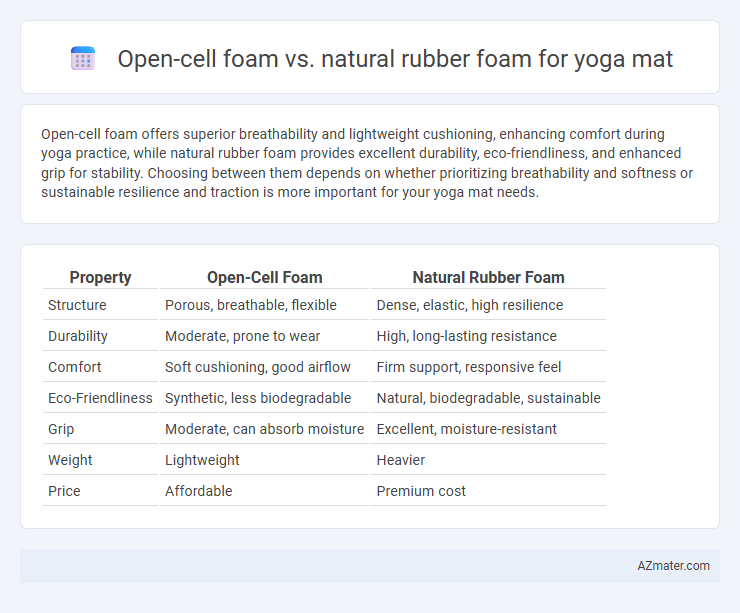Open-cell foam offers superior breathability and lightweight cushioning, enhancing comfort during yoga practice, while natural rubber foam provides excellent durability, eco-friendliness, and enhanced grip for stability. Choosing between them depends on whether prioritizing breathability and softness or sustainable resilience and traction is more important for your yoga mat needs.
Table of Comparison
| Property | Open-Cell Foam | Natural Rubber Foam |
|---|---|---|
| Structure | Porous, breathable, flexible | Dense, elastic, high resilience |
| Durability | Moderate, prone to wear | High, long-lasting resistance |
| Comfort | Soft cushioning, good airflow | Firm support, responsive feel |
| Eco-Friendliness | Synthetic, less biodegradable | Natural, biodegradable, sustainable |
| Grip | Moderate, can absorb moisture | Excellent, moisture-resistant |
| Weight | Lightweight | Heavier |
| Price | Affordable | Premium cost |
Introduction: The Importance of Yoga Mat Materials
Open-cell foam and natural rubber foam are two popular materials for yoga mats, each offering distinct benefits for comfort and performance. Open-cell foam provides excellent breathability and cushioning due to its porous structure, enhancing grip and moisture absorption during intense practices. Natural rubber foam, derived from sustainable sources, offers superior durability, natural elasticity, and eco-friendliness, making it an ideal choice for environmentally conscious yogis seeking resilient and non-toxic mats.
What is Open-Cell Foam?
Open-cell foam, commonly used in yoga mats, features interconnected pores that allow air to flow freely, providing superior breathability and cushioning during workouts. This foam type offers excellent shock absorption and lightweight comfort but tends to absorb moisture quicker than natural rubber foam, which has a closed-cell structure that repels water. Natural rubber foam, derived from latex, delivers enhanced durability, elasticity, and eco-friendliness, making it a popular alternative for those seeking sustainability and a non-toxic surface.
What is Natural Rubber Foam?
Natural rubber foam is a sustainable, eco-friendly material derived from the latex sap of rubber trees, known for its resilience, durability, and high elasticity. Unlike open-cell foam, natural rubber foam provides excellent cushioning and superior grip, making it ideal for yoga mats that require both comfort and stability during practice. Its hypoallergenic and biodegradable properties enhance its appeal for environmentally conscious yoga practitioners seeking non-toxic, long-lasting mats.
Cushioning and Comfort Comparison
Open-cell foam offers superior cushioning for yoga mats due to its lightweight structure and high breathability, providing enhanced comfort during extended practice sessions. Natural rubber foam delivers excellent resilience and firm support, maintaining shape and offering a more grounded, stable surface for balance poses. While open-cell foam excels in softness and shock absorption, natural rubber foam is preferable for durability and eco-friendly properties, catering to different comfort preferences.
Grip and Traction Differences
Open-cell foam yoga mats provide superior grip due to their porous texture, which absorbs moisture and prevents slipping during intense sessions. Natural rubber foam offers exceptional traction even when wet, thanks to its dense, non-porous surface that maintains stability on smooth floors. Both materials enhance yoga practice, but choice depends on whether moisture absorption or consistent dry traction is prioritized.
Durability and Longevity
Open-cell foam yoga mats typically offer superior cushioning but tend to wear out faster due to their porous structure, making them less durable over extended use. Natural rubber foam mats provide enhanced durability and longevity because of their dense, resilient composition that resists tearing and compression. For users seeking a long-lasting yoga mat, natural rubber foam is generally the better investment in terms of sustained performance and structural integrity.
Environmental Impact and Sustainability
Open-cell foam yoga mats typically use synthetic materials like polyurethane, which are not biodegradable and contribute to microplastic pollution, whereas natural rubber foam is derived from renewable resources like Hevea brasiliensis trees and is biodegradable, reducing environmental footprint. The production of natural rubber foam involves less energy consumption and fewer toxic chemicals compared to synthetic open-cell foam, enhancing its sustainability profile. Disposal of natural rubber foam yoga mats is eco-friendlier due to natural decomposition, while synthetic foams often persist in landfills for decades.
Maintenance and Cleaning
Open-cell foam yoga mats require frequent cleaning due to their porous structure, which absorbs sweat and moisture, promoting bacterial growth if not properly maintained. Natural rubber foam offers superior resistance to dirt and moisture, making it easier to clean with a simple wipe-down or mild soap solution without compromising durability. Both materials benefit from regular air drying to prevent mold and extend the mat's lifespan.
Price and Value Considerations
Open-cell foam yoga mats generally offer a lower price point compared to natural rubber foam, making them accessible for budget-conscious buyers. Natural rubber foam mats provide enhanced durability, eco-friendliness, and superior grip, justifying their higher cost through long-term value and performance benefits. Investing in natural rubber foam mats trends toward better sustainability and resilience, which appeals to consumers prioritizing quality over initial expense.
Which Yoga Mat Foam is Right for You?
Open-cell foam yoga mats offer superior breathability and cushioning, making them ideal for practitioners who prioritize ventilation and comfort during sweat-intensive sessions. Natural rubber foam mats provide excellent durability and eco-friendliness, with non-slip properties that enhance stability for poses requiring balance. Choosing the right yoga mat foam depends on whether you value moisture-wicking breathability or sustainable, resilient support for your practice.

Infographic: Open-cell foam vs Natural rubber foam for Yoga mat
 azmater.com
azmater.com